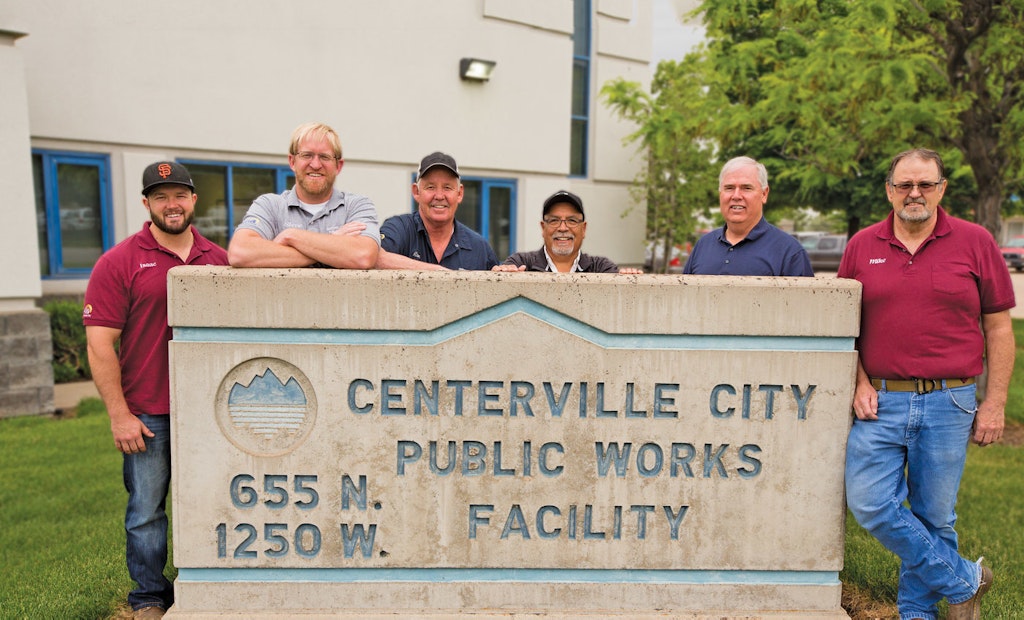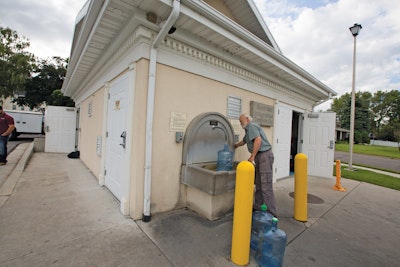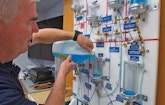
Water operators (from left) Isaac Kershner, Steve Hunt, Ron Blackman and Sam Lovato, Public Works Director Randy Randall, and Water Supervisor and Assistant Public Works Director Michael Carlson at the City Public Works Facility in Centerville, Utah. (Photography by Sallie Shatz)
The water distribution system in Centerville, Utah, has been recognized for its accomplishments, and it’s because Randy Randall thinks about harmony.
That isn’t a touchy-feely idea — it’s practical, says Randall, public works director. It grows from recognizing the energy inherent in moving water and from understanding the needs of the local electric utility. Combined with Randall’s enthusiasm for testing to determine what’s really happening, the approach has saved hundreds of thousands of dollars in power costs.
Centerville (population 16,500) is one of a string of suburbs north of Salt Lake City at the feet of the Wasatch Mountains. Most of the available land has been developed, and the population is expected to top out at about 20,000. Future development will consist of apartment buildings and other high-density uses.
Knowing the system
The water system draws from six wells that require no chlorination and from the Weber Basin reservoir that’s operated by another entity (some chlorination is required because the source is surface water). “One of our geographical blessings is we’re against the mountains, so we can place reservoirs there and don’t have to construct tall towers,” Randall says. All that water in a high place carries energy, and in Randall’s view, it is better to use and manage that energy than to let it dissipate and then add energy with a pump.
“You need to know how your system operates: What are the loads? What are the demands?” Randall says. “I’ve been here long enough to know how much we need to pump per day, per week, and per year.” A few years ago, the system used 60 hp booster pumps, but they were running for one hour a day. Randall had a different goal: using smaller pumps during off-peak hours for the utility.
“We allow our reservoirs to act as a battery,” he says. “We used to refill the reservoirs completely. Because the smaller pumps don’t refill completely, the reservoirs drop a little bit more every day. At the end of a week, they’re typically 10 percent lower, and we refill completely over the weekend. There’s no hurry to fill the reservoir. As long as we have enough storage for fire flow and daily demand, what’s the rush?”
Switching to smaller pumps cut the system’s cost. A variety of 5 hp and 7.5 hp pumps move water into and out of the reservoirs. The larger pumps are still in place in case of need, such as to refill a reservoir that has been drained for cleaning. When the big pumps need testing, Randall doesn’t start them with utility power; he hauls a portable generator to the pump house. Generators need to be exercised, and even at the city’s low rates, starting a large pump incurs a $600 demand charge.
Moving water naturally
The distribution system is split into five zones, and a series of electronic and hydraulic valves allow water that’s flowing down from the reservoirs to move among zones by gravity. “It’s really like a card game where you strategize to reduce the kilowatt hours,” Randall says. “And power companies want loads spread over 24 hours. They want lower and longer loads.”
Pump houses are built into hillsides because surrounding them with earth on three sides insulates them. The area’s winds brought a new problem and a new idea. “We have strong east winds,” Randall says. “My dad’s gas station was blown down twice, and we’ve had trains blown over. During one windstorm, air blowing through the vents in pump houses froze the pipes.”
In response, the Centerville team built vent covers insulated with an inch of foam. In summer, they’re removed so fans can cool the pump house. For winter, they snap onto a frame. During a winter day, sunlight heats the pump house interior. At night, the temperature remains above freezing because of the insulation and heat from the pumps.
Power of testing
Testing is a hallmark of the approach taken by Randall and his team, which includes Mike Carlson, water superintendent; Sam Lovato, water worker I; and Ron Backman, Steve Hunt, and Isaac Kershner, water workers III. Testing is how the team measured leakage in the system. “It took a year to do all that, and one question I asked myself was how much water was leaking through people’s homes every day?” Randall says.
The team collected data on baseline water usage, doing the testing at night when usage is minimal. They measured the flow in each zone by routing water around the pressure-reducing valve and through a small meter that’s sensitive enough to detect a change of only 1 gpm. Using bypass pressure-reducing valves, recording flowmeters, and recording pressure gauges, Randall found the baseline: a 13 percent discrepancy between water produced and water sold.
“Our conclusion was that on average about 0.02 gallons per minute is lost in each building’s water system through leaks,” Randall says. “They can’t make a meter for those low flows. It’s just cost prohibitive, so you’re accepting some loss in the system.” The team tested all five zones in the system and found another twist: Areas with multiple rental dwellings lost about 0.07 gpm on average. They concluded that leaky faucets and fixtures in those homes were not being repaired. Overall, the city was losing an estimated 112 gpm at its 5,500 connections. Randall verified that by checking wastewater flows.
Randall is using this information as a baseline so he can spot problems in the future. There is the possibility of launching a program to encourage people to fix leaky fixtures — or even to provide money for them to do so — but the electricity cost to produce the lost water is only $5,000 to $6,000 a year, and any leak-fixing grant program would exceed that cost.
Power economics
A good deal of what Randall has accomplished was possible because he took time to understand the power utility. “I had to talk to an incredible number of people to understand what’s really going on and how the power company operates,” he says. “One of the most important things I learned was how to read a power meter.”
One dial registers demand, and another records the date and time; that is important to on- and off-peak billing. Randall knows what day of the month the utility reads the meters; he also knows that it happens between 7 a.m. and 3:30 p.m. He and his team plan the use of pumps around that day and time. For example, if they want to switch from using Well 1 to Well 2, they do it on the day when the meter is read and after 3:30 p.m., which is during off-peak hours. As a result, there is only one demand charge for each month: one charge for the Well 1 pump on the day before the meter is read, and one charge for the Well 2 pump on the day the meter is read.
By managing when pumps come online, the team eliminates an extra demand charge. One day when Randall was out of the office, a pump went down, and the technicians could not get it back online. The power meter was scheduled for reading a few days later, so they opened a valve and bought water from the city’s outside supplier. That saved about $1,000 for a demand charge. Savings from such decisions add up.
Centerville pumps 99 percent of its water using off-peak power. About five years ago, Randall calculated that careful management had saved the city about $266,000 in annual power charges. Since then, the system’s energy bill has continued to drop by about $10,000 per year. Randall’s analysis shows that energy charges account for about 38 percent of each power bill and demand charges account for about 25 percent. “It takes a lot of time to figure out what the power company really wants you to do, but if you do that, you can save a lot of money by working within their parameters,” he says.
Applying technology
Advanced SCADA equipment enables the team to keep the system running at peak performance. They also use the system to isolate leaks: It’s a side benefit of running pumps at night to take advantage of off-peak power costs. That means the entire day is a continuous leak test.
“I looked at the SCADA system for one zone, and I said, ‘That has changed,’” Randall says. “I’m talking about the slope of the graph on the screen that shows the demand on a reservoir. It was more than usual, and that means there’s a leak. And all of this comes back to the principles of observation and understanding what the observation means. I looked at the previous week’s graph, and I noticed the change.”
Over 18 months, the SCADA system revealed three leaks that didn’t break through on the surface. Using the valves installed for cross-connecting supply zones, the team fed one section of a suspected zone from one reservoir and another section from another zone. They progressively isolated smaller and smaller areas, and by watching the pitch of the graphs on the SCADA system, they could see which section had the leak.
The Centerville system has won efficiency awards from the Rural Water Association of Utah and the National Rural Water Association. One event that started the utility on that road was fire protection: A test found that some areas of the city with larger structures needed higher flows to the hydrants than existed. Randall obtained money for one check valve and two pressure-reducing valves to interconnect distribution zones and increase flows for emergency demands. Then, he considered how more valves could cross-connect zones so water could move under its own energy.
“One thing built on another, and here we are,” Randall says. “I truly love to analyze and figure out how things function and how they work. I understand a lot of the principles of nature. From youth I’ve been interested in those concepts.”
A low-tech backup
While advanced SCADA equipment is beneficial in running a water distribution system, there are risks with any computer connected to the internet. So, the Utah city of Centerville developed a communications loss plan, or CLP.
It is a single-page document that shows technicians how to position valves and switches to operate the system if communications are out completely and all the computers are down, says Randy Randall, public works director. To make the plan work, the system has backups incorporating older mechanical technologies. Floats govern flows into a reservoir. Outside one reservoir is a plastic tube with a yellow ball in it to show the level of water. The other reservoirs connect to it, so one tube shows the level of all three.
“We have run our system for two to three weeks at a time using the CLP just to test it,” Randall says. “It really works quite well.” Under normal operations, iPad tablets tell technicians what’s happening in the system and allow them to control it. If someone manages to break in and interrupts the telemetry, the system shuts off communications with the tablets and can be operated without an internet connection. This provides another option before the CLP is needed.
Randall is not worried about hackers. He has taught cybersecurity for water systems and observes that the amount of information flowing through a SCADA system makes successful attacks difficult. Centerville’s system is relatively small, yet it gathers thousands of points of data, from the water depths in wells to the temperatures inside buildings.
A hacker might change a parameter or two but wouldn’t understand enough to dynamically change the system, Randall says. Also, the SCADA computer issues commands over UHF radio, which is not subject to internet hacking. At the same time, people who work closely with any system know it. By observing information in the SCADA system, he says, they will know when something is abnormal.








